A Detailed Explanation of NFT Wash Trading and the Reasons Behind It
Authors: CoinGecko, Footprint Analytics Joint Report
There is a saying in the market that the entire NFT market's trading is essentially fraudulent and is a facade manipulated by wash traders. We often see many media headlines promoting this notion. After all, why would someone spend millions of dollars on a JPEG image?
Wash trading refers to the act of traders repeatedly buying and selling the same asset to manipulate trading volume and/or asset prices. The parties involved may consist of a single entity or multiple entities. In traditional capital markets, wash trading is illegal because its intent is usually to mislead other buyers/sellers into believing that the asset's value is far higher than its actual value, and/or that there is good market liquidity for the asset.
However, in the cryptocurrency space, particularly in the NFT market, there are no strict regulations, so the phenomenon of wash trading can sometimes be rampant. In addition to the aforementioned reasons for wash trading, there are two reasons unique to the NFT market: tax evasion and earning trading platform token rewards.
Wash Trading Behavior for Price/Liquidity Manipulation
Hype is everything for NFTs. NFT projects will do everything they can to attract attention and create buzz. The simplest way to gain hype is to appear on the homepage of NFT marketplaces. Platforms like OpenSea, LooksRare, and Magic Eden have interfaces that showcase popular NFT projects.
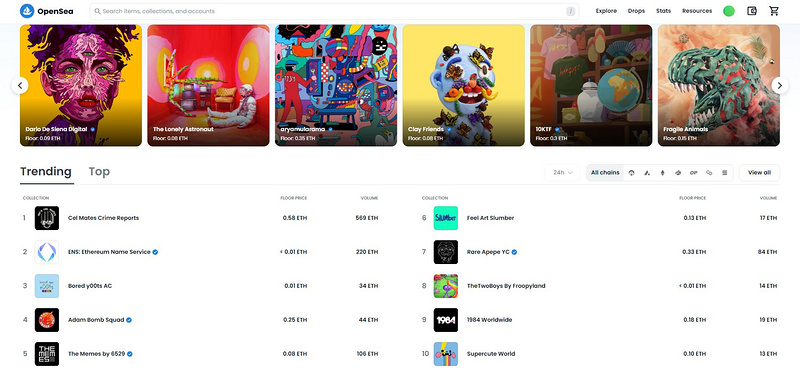
Source: OpenSea
While no marketplace explicitly states how their hype algorithms work, trading volume is clearly an important factor in the hot list. The mechanism that allows high trading volume to enter the hot list incentivizes NFT founders to increase their trading volume through wash trading, thereby increasing the chances of their projects being listed on the hot list. Wash trading also gives the market a false impression of liquidity, creating a false sense of confidence that there is significant demand and hype for the NFTs they are about to purchase. This leads unsuspecting buyers to purchase the project's NFTs at inflated prices.
One example of wash trading we have identified is PixBattle #1, a gaming project that claims to be the first pixel game NFT on Solana.
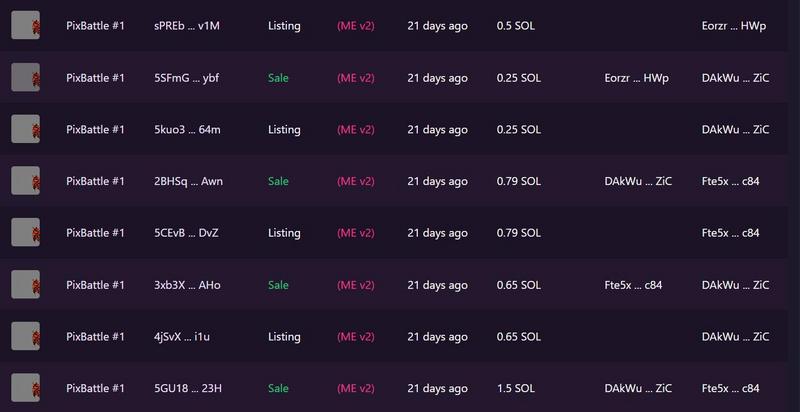
Source: Magic Eden
From the screenshot above, you will notice that an NFT is repeatedly traded between two addresses within a single day. There is no other reason for this to happen besides faking trading volume and hype. The wash traders also did not bother to hide their wash trading tracks by using two different addresses. Additionally, the NFT involved in the wash trading is #1 ID (the first NFT minted from the contract). This increases the likelihood that the wash trader is the founder of the series, as they know when the series can be minted and are likely the first NFT's minter.
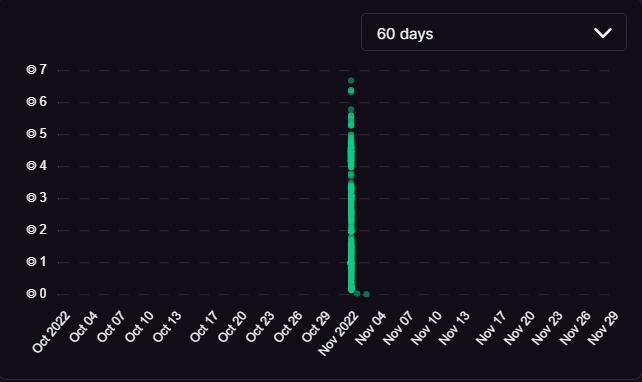
Source: Magic Eden
From the price chart on Magic Eden, we can see that some unsuspecting buyers purchased at the peak before liquidity dried up and the price dropped to 0.
Identifying Wash Trading
Because wash trading involves many factors, it is nearly impossible to identify all projects with wash trading. Here are some common signs of wash trading to watch out for:
- The trading of collectibles is at stable price levels (i.e., no high-priced "rare" trades).
- High trading volume/liquidity for collectibles, but low visibility/poor social media metrics (e.g., low Twitter follower count).
- An NFT is purchased more times in a day than usual.
- An NFT is repeatedly purchased by the same buyer address within a short time frame, such as 120 minutes.
Wash Trading Behavior to Realize Trading Losses for Tax Reduction
Another reason for wash trading is to realize trading losses to reduce personal taxes. Jurisdictions like the United States and Europe treat NFTs as assets and impose some form of capital gains tax. This means traders pay taxes on gains, but they can typically offset taxes with investment losses realized in the final tax calculation. However, this only applies to trades where investors have realized gains or losses. In this case, buyers who bought NFTs at high prices and are now stuck may actually be incentivized to sell their NFTs at a loss to realize the loss and offset gains from other investments. Legally, realizing trading losses to reduce taxes is neither uncommon nor illegal.
In the NFT market, wash trading is a method to realize trading losses. Traders can sell NFTs to another wallet they control to create a false "loss." For example, setting the NFT price at 1 USD and selling it to another of their wallets to realize a loss. This allows traders to retain the asset while realizing a loss for tax reduction.
If we look at the top 10 NFT projects on ETH, we can see that project holders have indeed taken advantage of this.
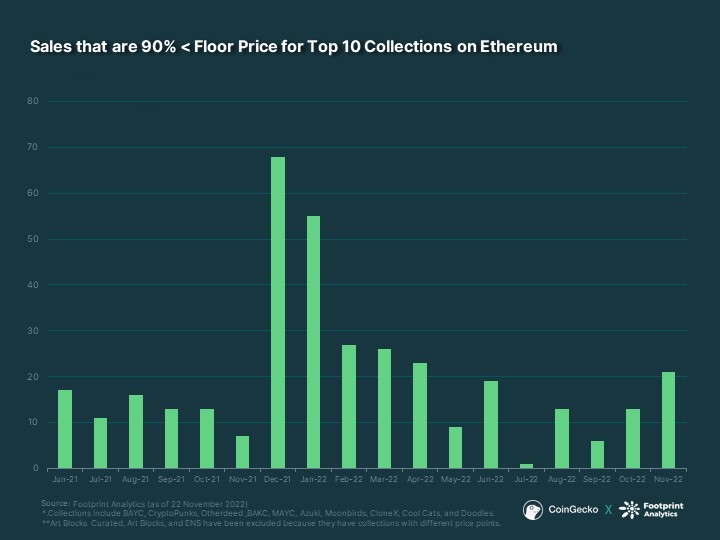
Source: Footprint Analytics (as of November 22, 2022)
The above chart includes all NFT trades where the floor price was below 90%. The highest monthly sales occurred in December 2021, followed by January 2022. Coincidentally, this is the month for tax reporting in many jurisdictions. We can safely assume that most (if not all) of the trades below 90% floor price during these periods involved the intent to realize trading losses for tax reduction.
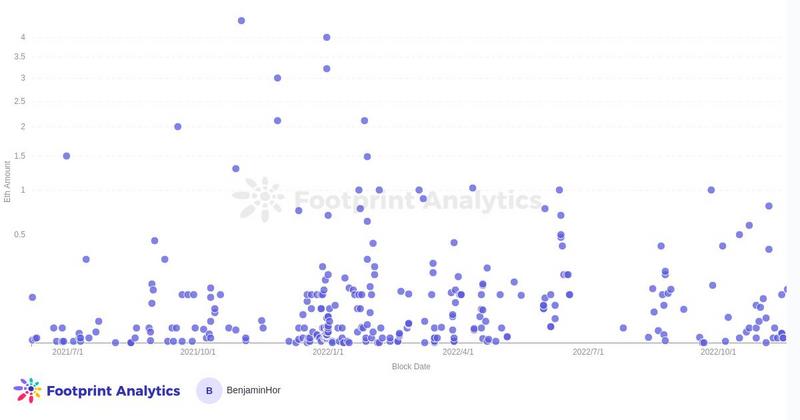
Source: Footprint Analytics (as of November 22, 2022)
Among the top 10 projects, the three most popular for realizing trading losses are MAYC (117), Cool Cats (74), and CloneX (61). The wash traders for these projects seem to be selling their NFTs at extremely low prices. Below 0.5 ETH, close to 0, making them obvious outliers to any on-chain observer.
That said, it is worth mentioning that these low-priced sales may have other reasons, such as sellers mispricing the sale price or offering some friendly price reserved for a specific address.
Token Wash Trading
LooksRare and X2Y2 are the most well-known tokenized NFT marketplaces. Platform tokens are distributed to large traders on the platform as trading rewards. Wash traders exploit this mechanism by trading back and forth between wallets they own, generating extremely high trading volumes daily to maximize their trading reward returns. To identify these types of wash trades that earn trading rewards, we filtered wash trades on LooksRare and X2Y2 based on the following rules:
- NFT trades priced excessively high (X times higher than OpenSea's average price).
- Collectibles with 0% royalties (except for CryptoPunks and ENS).
- The number of NFT purchases exceeds the normal amount in a day.
- NFTs purchased by the same buyer address within a short time frame.
After filtering with these rules, we found that over 80% of the trading volume since the launch of these two NFT trading platforms has been wash trading:

Source: Footprint Analytics (as of November 22, 2022)
From the above chart, we can see that LooksRare has a higher volume of wash trading. We believe this is because its trading rewards are more generous. We calculated the total value of trading rewards based on the daily closing price of each token since its launch. Here are the results as of November 22, 2022.
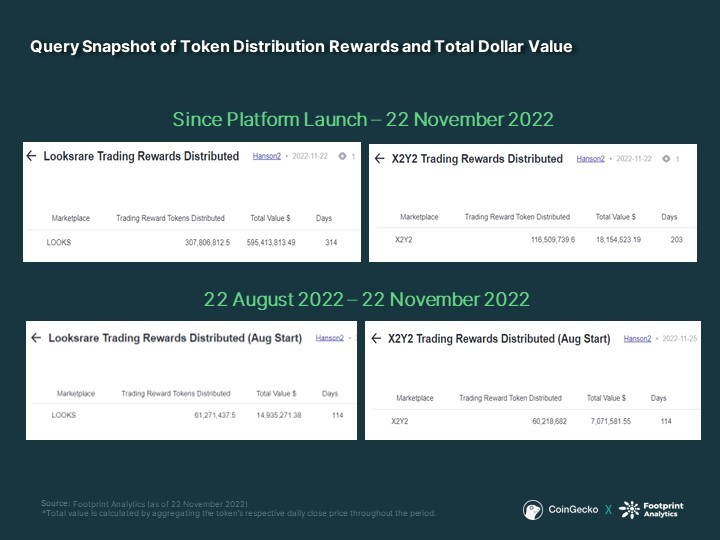
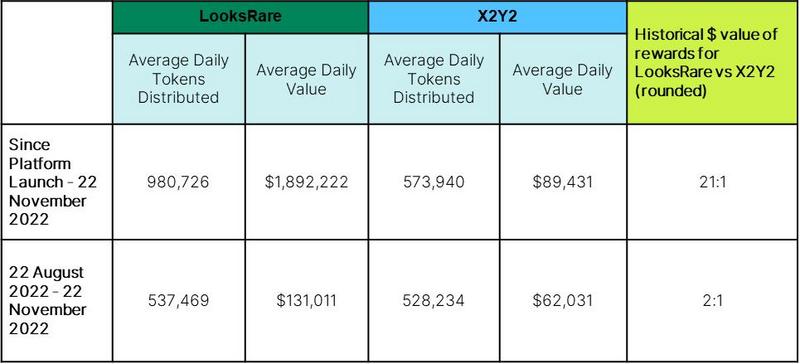
Source: Footprint Analytics (as of November 22, 2022)
If we calculate based on historical averages, for every dollar you earn from trading rewards on X2Y2, you would earn an additional 21 dollars on LooksRare. However, this figure is misleading because LooksRare launched about 3 months before X2Y2, when the market was still booming, and the price of LOOKS (LooksRare's token) was much higher. After the initial hype subsided and the bear market began, trading rewards started to shrink to more even levels. Even so, the dollar value offered by LooksRare over the past three months is still double that of X2Y2.
However, these are just broad assumptions, as rewards largely depend on the percentage of daily trading volume on each platform. If total trading volume is low (thus providing sellers with a higher percentage of trading rewards).
Interestingly, while LooksRare distributes more value on average, X2Y2 has more real trading volume. From June to now, X2Y2 has had higher monthly trading volume than LooksRare. (Not considering wash trading volume)
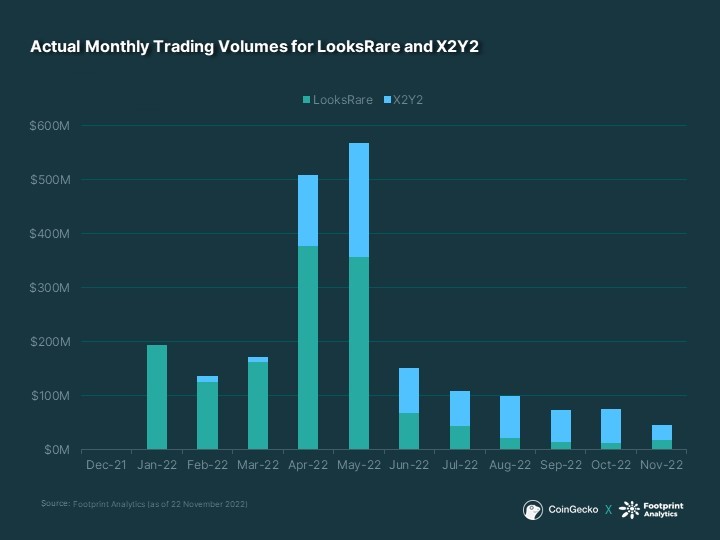
Source: Footprint Analytics (as of November 22, 2022)
A possible explanation for X2Y2's higher real trading volume compared to LooksRare is lower trading costs. X2Y2 currently charges a 0.5% trading fee and offers optional royalty fees (although this feature was revoked on November 18, 2022), while LooksRare has a higher trading fee (2.0%). However, even considering LooksRare's higher trading fees, trading on LooksRare is always cheaper after offsetting token rewards. We can only speculate that X2Y2's marketing strategy is more effective in a context where human psychology prefers "discounts" over "cash back." As of November 22, 2022, LooksRare's average token staking return (53.61%) is higher than X2Y2's (38.81%).
In-depth Analysis of the Trading Patterns of LooksRare / X2Y2 Wash Traders.
We have identified over 6442 addresses engaged in wash trading on LooksRare and X2Y2. The top 10 addresses all come from LooksRare, which aligns with the premise that LooksRare's token rewards are more valuable.
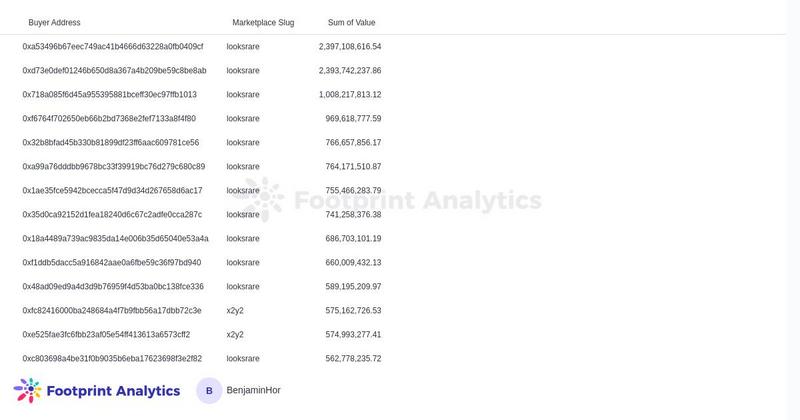
Source: Footprint Analytics (as of November 22, 2022)
These traders have two distinct peak trading times, between 8 AM to 9 AM (UTC+0) and at the end of each day.
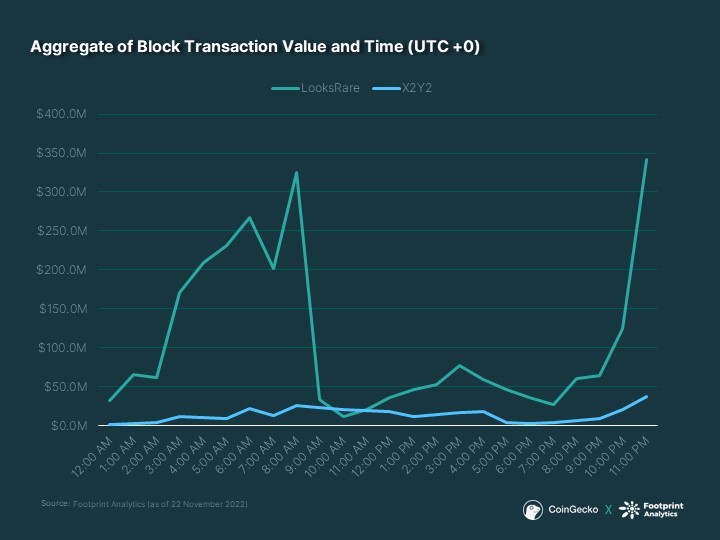
Source: Footprint Analytics (as of November 22, 2022)
Trading before the day's close is said to be a strategy because they may be trying to increase their daily trading volume share in the market. Since trading rewards are based on a percentage of the market's total daily trading volume, traders will conduct wash trades as late as possible to secure the desired trading volume for maximum reward share. As for the morning peak, we speculate that these traders operate close to midnight in their time zones, which coincides with late night in the U.S.
In terms of the most popular projects used for wash trading, Terrafroms by Mathcastles ranks first. This series has over $1.2 billion in wash trading, accounting for 99.82% of the collective trading volume of this series on LooksRare and X2Y2.
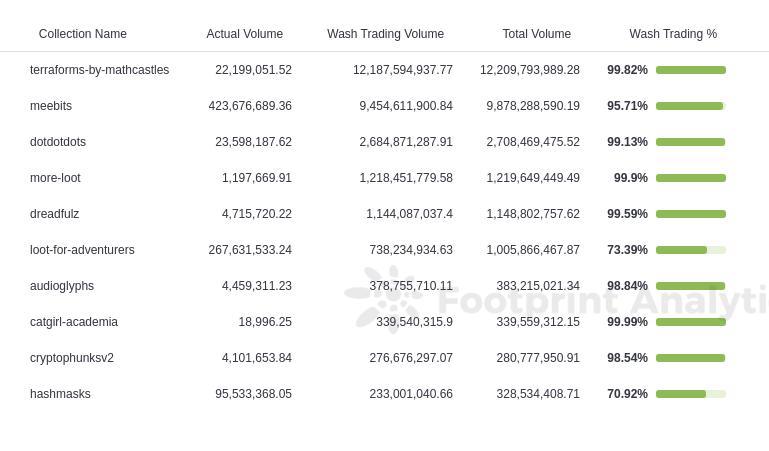
Source: Footprint Analytics (as of November 22, 2022)
We are not sure why this is the case. However, we found that the commonality among these NFTs used for wash trading is that they have zero royalties. This means the cost of wash trading is lower. We can only assume that a large whale or a group of whales has designated this as their preferred wash trading NFT. If we look at the list of wash traders for Terraform, the top 2 wallets have trading volumes close to $4.8 billion.
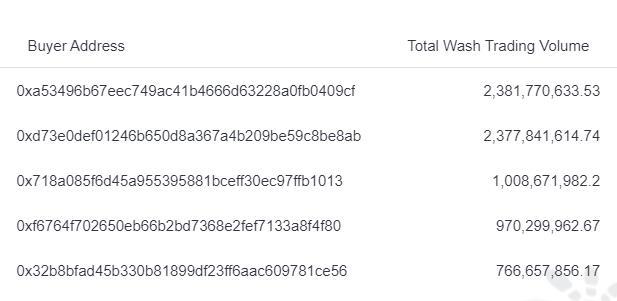
Source: Footprint Analytics (as of November 22, 2022)
This is likely a single whale trading between their wallets, accounting for over 1/3 of the wash trading volume.
However, before Terraform NFTs became the top wash traded, it is worth noting that Meebits had been a favorite among wash traders until they implemented royalties in September 2022. The wash trading volume then disappeared overnight.
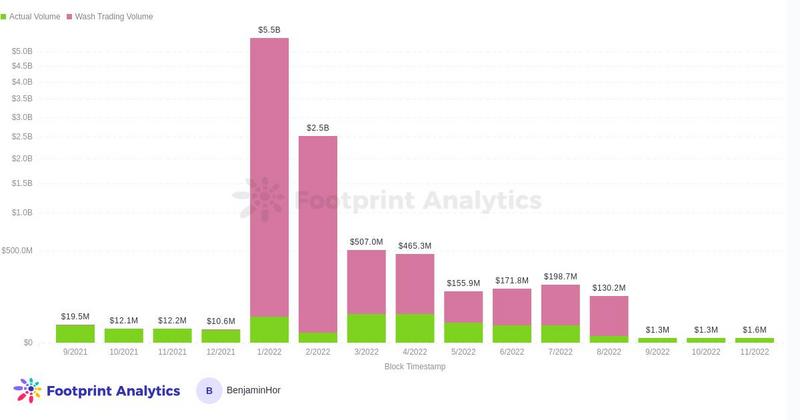
Source: Footprint Analytics (as of November 22, 2022)
Conclusion
Without proper regulation and enforcement, NFT wash trading is an inevitable phenomenon in the NFT market. In traditional markets, manipulating prices/quantities and fraudulently realizing tax losses are illegal, and this standard should apply to cryptocurrencies as well. On the other hand, earning token rewards through wash trading is a new activity unique to cryptocurrencies. While the primary victims facing risks here are the market itself, unsuspecting users may also suffer losses during this activity. Despite the ethical issues, veterans in the crypto space argue that code is law. If the NFT market itself imposes no restrictions on reward distribution, why shouldn't users exploit this "loophole"?
Considering all of this, it is no wonder that everyone thinks NFTs are a scam. If we look at the total wash trading volume on ETH, the situation is not very pretty.
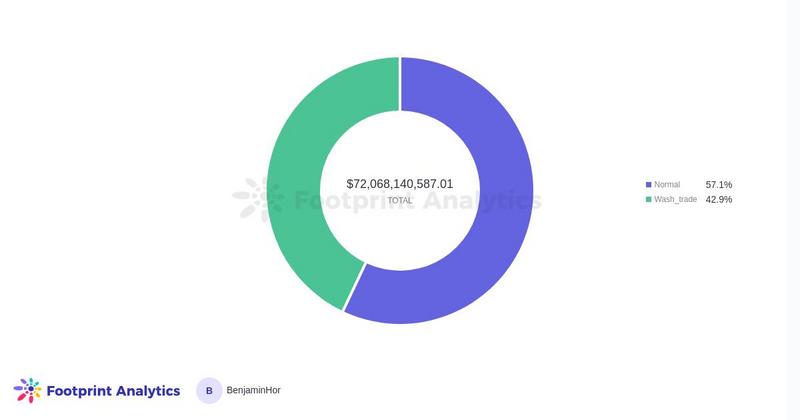
Source: Footprint Analytics (as of November 22, 2022)
Of all trading volume, 42.9% is wash trading volume. The sensational explanation is that nearly half of the market is a scam; however, a more reasonable inference is that platforms like LooksRare and X2Y2 have propped up the market with fake trading volume. Moreover, this does not change the fact that there are real buyers present. In fact, if we use different metrics (i.e., transaction count) to measure the market, a completely different picture emerges.
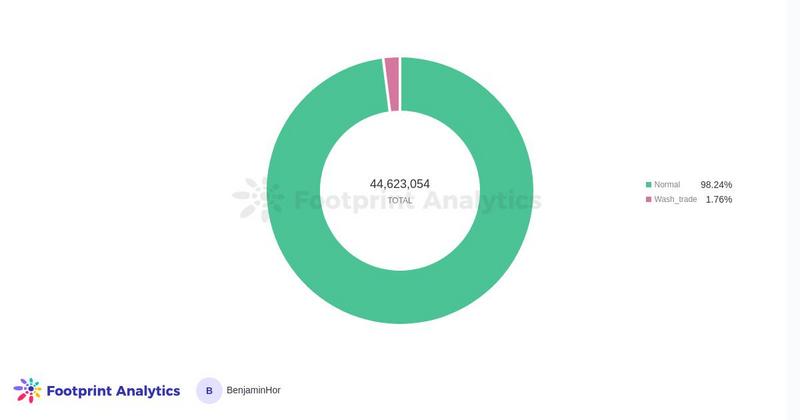
Over 98% of total transaction units are real transactions. In other words, people may just like JPEGs. A study on OpenSea NFTs by a group of researchers also supports this argument, albeit using a different approach.
But this does not mean we should take things for granted. Blockchain technology makes every transaction transparent, making it easier for us to identify fake transactions and protect ourselves.
The first line of defense is education. NFT traders should learn to recognize patterns of fake wash trading before buying lesser-known NFTs. Even so, some of the most popular collectibles (like Meebits) may not be immune to this activity. However, we can also expect wash traders to become increasingly sophisticated and cover their tracks. Improvements in on-chain analysis and efforts to use platforms like Footprint Analytics can help users filter out noise and make better trading decisions.
NFT trading platforms should also play a more active role in preventing wash trading, as it harms both actual users and themselves.










